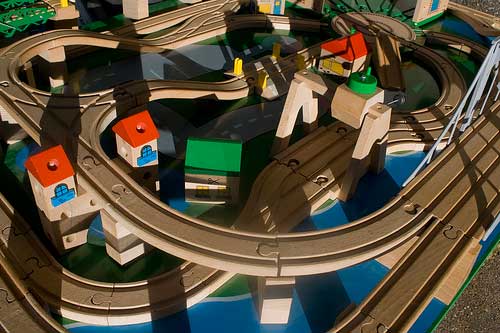The U.S. is going from one financial crisis directly into another, as SAFETEA-LU, the omnibus transportation bill, expires next month, writes Roxanne Blackwell of the American Society of Landscape Architects.

As Congress wrapped up its work on a debt ceiling deal to avert a worldwide financial catastrophe, another crisis is looming down the road – literally. In less than 60 days, our nation's surface transportation law will expire on September 30th, leaving the country's highways, roads, streets, bridges and other infrastructure vulnerable. Today, our infrastructure is crumbling and in dire need of repair, congestion is clogging our transportation arteries, impeding commerce and economic development, and families are incurring major costs to travel to and from daily destinations. Congress must take action to pass a comprehensive transportation bill that will not only repair our current infrastructure and better expedite the movement of goods and services but also meet the current demands of American households.
Congress passed the last omnibus transportation bill, SAFETEA-LU, in 2005 and has "kicked the can" down the proverbial street by merely extending the measure multiple times since its first expiration in 2009. But now Congress' dawdling on the issue is accruing a significant price tag for the nation. A recent report by the American Society of Civil Engineers calculates that "the cost of failing to invest more in the nation's roads and bridges would total $3.1 trillion in lost GDP growth by 2020. For workers, the toll of investing only at current levels would be equally daunting: 877,000 jobs would also be lost." Already, the report found, that "deficient and deteriorating surface transportation cost us $130 billion in 2010."
More importantly, individual households are feeling the economic pinch from the lack of a comprehensive transportation policy that fits the needs of today's American family. Currently, many Americans are forced to take costly automobile trips for all their daily activities, including routine activities less than one mile from home. Schoolchildren cannot safely walk or bicycle to and from school and instead must rely on lengthy school bus trips that many school districts can no longer afford. Now, more than ever, Americans are clamoring to get out of their cars and have more transportation options than the car-centric approach first envisioned and deployed in the 1950s is providing. Recent studies have shown that an increased number of communities want nearby bicycle and pedestrian paths not only for recreational opportunities, but also to provide accessible networks to transit, shopping, school, work, and other daily routines. Not only will this save individuals and families thousands of dollars in transportation costs each year, it will also increase the value of their homes and other nearby real estate, and attract economic development.
The U.S. Conference of Mayors recently surveyed its members about transportation infrastructure priorities, revealing that 75 percent of the polled mayors would support an increase in the gas tax if a greater share of the funding were invested in bicycle and pedestrian projects. These mayors went on to disclose that the lack of funding for bicycle and pedestrian projects was the biggest challenge to using transportation as part of their communities' broader strategies to reduce congestion, improve livability, and increase economic competitiveness.
Further, with the nation's unemployment rate still hovering at nine percent, the impact of bicycle and pedestrian projects on job creation must be underscored. According to a recent Political Economy Research Institute study,bicycle and pedestrian projects create about 11.4 jobs for every one million dollars spent compared to 7.8 jobs created through road projects.
The Federal Transportation Enhancements (TE) program, first established in 1992 as part of the surface transportation law known as ISTEA, is the major source of dedicated federal funding to create bicycle and pedestrian projects. Given the needs of today's communities, a robust TE program must be a critical component of any comprehensive surface transportation bill. Since its inception, the TE program has provided communities across the country with dedicated funding to design and construct bicycle and pedestrian projects. But clearly more is needed. The TE program is oversubscribed in many states, with requests about three times the available funds. Moreover, the Alliance for Bicycling and Walking reported that bicycling and walking make up 12 percent of all trips made in the United States, but receive less than 2 percent of federal funding.
Recently, both the House and Senate unveiled blueprints for a new transportation policy. House Transportation and Infrastructure Chairman John Mica's (FL) proposal is a six-year bill with a 35 percent across-the-board cut to existing transportation programs and the elimination of dedicated funding for bicycle and pedestrian programs, including the successful Transportation Enhancement program. Senate Environment and Public Works Chair Barbara Boxer (CA) released an outline of her bipartisan Moving Ahead for Progress in the 21st Century (MAP-21), a two-year reauthorization that would consolidate several core transportation programs, leaving the fate of TE unclear.
 When Congress returns from its recess in September, it must immediately return to "crisis mode" and focus its attention on crafting a well-balanced surface transportation policy that can repair our nation's crumbling infrastructure and meet the present-day needs of the citizenry, all while spurring economic development and creating much-needed jobs. A final bill must include policies and programs that promote the efficient movement of cars and other motor vehicles, invest in transit, and strengthen our bicycle and pedestrian networks. Continuing the Transportation Enhancements program will go a long way in achieving these and other national transportation goals.
When Congress returns from its recess in September, it must immediately return to "crisis mode" and focus its attention on crafting a well-balanced surface transportation policy that can repair our nation's crumbling infrastructure and meet the present-day needs of the citizenry, all while spurring economic development and creating much-needed jobs. A final bill must include policies and programs that promote the efficient movement of cars and other motor vehicles, invest in transit, and strengthen our bicycle and pedestrian networks. Continuing the Transportation Enhancements program will go a long way in achieving these and other national transportation goals.
Now is the time to contact your legislators to urge them to support the Transportation Enhancements program in the next reauthorization of the surface transportation bill.
Roxanne Blackwell, Esq. is Federal Government Affairs Manager for the American Society of Landscape Architects (ASLA).

Planetizen Federal Action Tracker
A weekly monitor of how Trump’s orders and actions are impacting planners and planning in America.

Chicago’s Ghost Rails
Just beneath the surface of the modern city lie the remnants of its expansive early 20th-century streetcar system.

Amtrak Cutting Jobs, Funding to High-Speed Rail
The agency plans to cut 10 percent of its workforce and has confirmed it will not fund new high-speed rail projects.

Ohio Forces Data Centers to Prepay for Power
Utilities are calling on states to hold data center operators responsible for new energy demands to prevent leaving consumers on the hook for their bills.

MARTA CEO Steps Down Amid Citizenship Concerns
MARTA’s board announced Thursday that its chief, who is from Canada, is resigning due to questions about his immigration status.

Silicon Valley ‘Bike Superhighway’ Awarded $14M State Grant
A Caltrans grant brings the 10-mile Central Bikeway project connecting Santa Clara and East San Jose closer to fruition.
Urban Design for Planners 1: Software Tools
This six-course series explores essential urban design concepts using open source software and equips planners with the tools they need to participate fully in the urban design process.
Planning for Universal Design
Learn the tools for implementing Universal Design in planning regulations.
Caltrans
City of Fort Worth
Mpact (founded as Rail~Volution)
City of Camden Redevelopment Agency
City of Astoria
City of Portland
City of Laramie


























